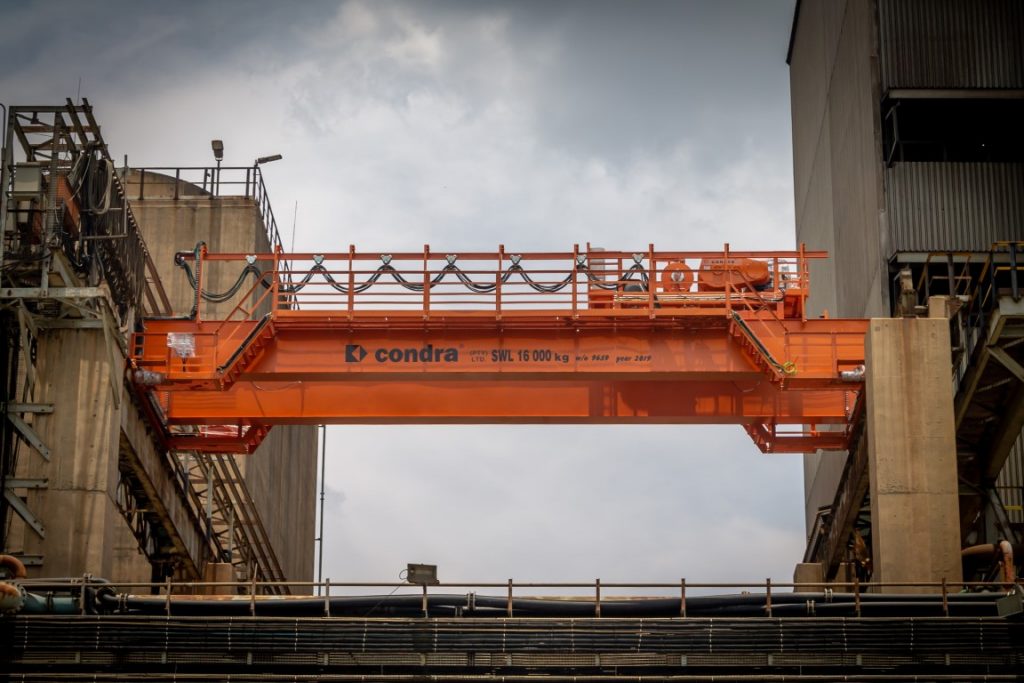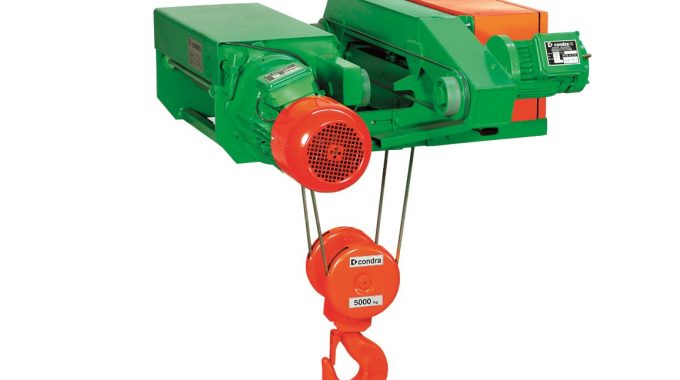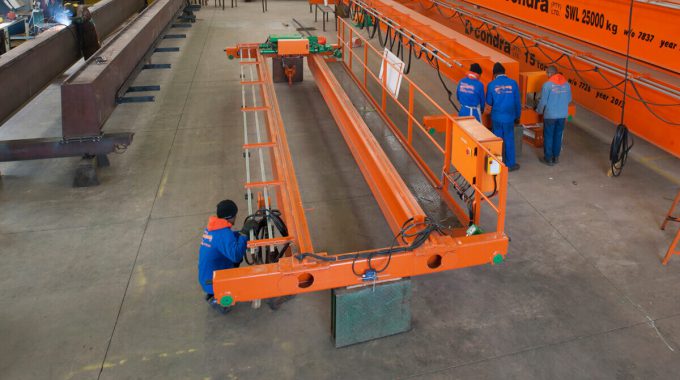BUY IN HASTE, REPENT AT LEISURE
The capital equipment buying decision carries risk. There is cost and, quite often, a deadline. The scale of financial outlay must be carefully considered: if incorrect choice leads to equipment underperformance or, worse, failure, a replacement will have to be bought. Care and caution are the watchwords.
Choosing a factory crane is especially tricky. Condra, a leading manufacturer of overhead cranes and hoists, offers the following advice to smooth the buying process and minimise risk:

First, quantify the cost of lost production in the event of a breakdown. Always high, this figure can become unimaginably so if long shipping times are needed for component parts to arrive, the equipment lying idle during this period. Yet the negative impact of crane breakdown can be minimised if technical support using locally held spare parts is immediate. Condra’s advice is to ask all would-be crane suppliers about their spare parts holdings – where are they stocked and, if abroad, how long would be the time delay between breakdown and spares arrival? If the answer is measured in weeks or months, be wary.
Condra guarantees delivery of its own spares within 48 hours in South Africa, and in five days anywhere else in Africa. Still, buyers at the time of equipment purchase are often dazzled by the glamour of European brands, or seduced by the low price of a Chinese-built machine. However, if a breakdown requires replacement of an end-carriage or crab, how long will it take for that component to arrive from the manufacturer? What will be the shipping time? How much production will be lost, and at what cost?
A second factor related to breakdown is the degree to which the crane may be described as robust. This is important because of the heavy-handed nature of many operators. Local environments are usually less forgiving than those in Europe, placing more stress upon the strength of the crane’s build.
Condra addresses this issue through a design philosophy focused on strength and durability. Its success is reflected in the company’s solid reputation for mechanical reliability under corrosive and abrasive environments, and under wide extremes of temperature, humidity and altitude. One example of the company’s robust crane design is to be found in rigid frame alignment, the girders being bolted to the end-carriages to ensure that accurate wheel alignment is maintained throughout operation, reducing wear on the wheel flanges.
A third element to be investigated is design expertise. All OEM equipment manufacturers design in-house, but the important question to ask is where that expertise is located. How readily accessible is the design office, and how willing are staff to discuss adapting product capabilities to the requirements of a particular application? If the manufacturer is located in Europe or China, then African customers will not have easy access to qualified consultation.
By contrast, Condra claims advanced levels of design flexibility and staff availability. The company’s design office is located at the main factory in Johannesburg, with qualified staff on had at a second works in Cape Town. There is direct representation in Durban. Europe is serviced and supplied from a subsidiary company in Gabrovo, Bulgaria.
With regard to technical support, Condra’s network of authorised agents has been in place for years. South Africa is fully covered, and there are qualified technicians at agents in Namibia, Kenya, Botswana and Zambia. The company is currently establishing service relationships with representatives in Mozambique, Zimbabwe, Tanzania and Angola. Internationally, Condra has agents in South America, Australia and the Middle East.
Condra’s advice: Think, before you buy. Do the necessary homework. Take your time, and always remember the old adage: Buy in haste, repent at leisure. It bears considering, coming as it does from a market leader with an almost 60-year pedigree in lifting applications across manufacturing, warehousing and mining. Condra claims a local product content higher than any other overhead crane supplier in central and southern Africa, with an adaptable product range for all applications: hook duties, grabbing, magnet, ladle, bucket or stacking applications, and operation manually, electrically, or in combinations. Typical configurations include single-girder and double-girder overhead travelling cranes, portal and semi-portal cranes, and cantilever cranes (pillar, jib, wall or walking). Hoists are manufactured in a number of standard models from 1 ton to 500 tons. Automation is optional across the range.
Choosing a factory crane is especially tricky. Condra, a leading manufacturer of overhead cranes and hoists, offers the following advice to smooth the buying process and minimise risk:

Condra fully automated overhead crane
First, quantify the cost of lost production in the event of a breakdown. Always high, this figure can become unimaginably so if long shipping times are needed for component parts to arrive, the equipment lying idle during this period. Yet the negative impact of crane breakdown can be minimised if technical support using locally held spare parts is immediate. Condra’s advice is to ask all would-be crane suppliers about their spare parts holdings – where are they stocked and, if abroad, how long would be the time delay between breakdown and spares arrival? If the answer is measured in weeks or months, be wary.
Condra guarantees delivery of its own spares within 48 hours in South Africa, and in five days anywhere else in Africa. Still, buyers at the time of equipment purchase are often dazzled by the glamour of European brands, or seduced by the low price of a Chinese-built machine. However, if a breakdown requires replacement of an end-carriage or crab, how long will it take for that component to arrive from the manufacturer? What will be the shipping time? How much production will be lost, and at what cost?
A second factor related to breakdown is the degree to which the crane may be described as robust. This is important because of the heavy-handed nature of many operators. Local environments are usually less forgiving than those in Europe, placing more stress upon the strength of the crane’s build.
Condra addresses this issue through a design philosophy focused on strength and durability. Its success is reflected in the company’s solid reputation for mechanical reliability under corrosive and abrasive environments, and under wide extremes of temperature, humidity and altitude. One example of the company’s robust crane design is to be found in rigid frame alignment, the girders being bolted to the end-carriages to ensure that accurate wheel alignment is maintained throughout operation, reducing wear on the wheel flanges.
A third element to be investigated is design expertise. All OEM equipment manufacturers design in-house, but the important question to ask is where that expertise is located. How readily accessible is the design office, and how willing are staff to discuss adapting product capabilities to the requirements of a particular application? If the manufacturer is located in Europe or China, then African customers will not have easy access to qualified consultation.
By contrast, Condra claims advanced levels of design flexibility and staff availability. The company’s design office is located at the main factory in Johannesburg, with qualified staff on had at a second works in Cape Town. There is direct representation in Durban. Europe is serviced and supplied from a subsidiary company in Gabrovo, Bulgaria.
With regard to technical support, Condra’s network of authorised agents has been in place for years. South Africa is fully covered, and there are qualified technicians at agents in Namibia, Kenya, Botswana and Zambia. The company is currently establishing service relationships with representatives in Mozambique, Zimbabwe, Tanzania and Angola. Internationally, Condra has agents in South America, Australia and the Middle East.
Condra’s advice: Think, before you buy. Do the necessary homework. Take your time, and always remember the old adage: Buy in haste, repent at leisure. It bears considering, coming as it does from a market leader with an almost 60-year pedigree in lifting applications across manufacturing, warehousing and mining. Condra claims a local product content higher than any other overhead crane supplier in central and southern Africa, with an adaptable product range for all applications: hook duties, grabbing, magnet, ladle, bucket or stacking applications, and operation manually, electrically, or in combinations. Typical configurations include single-girder and double-girder overhead travelling cranes, portal and semi-portal cranes, and cantilever cranes (pillar, jib, wall or walking). Hoists are manufactured in a number of standard models from 1 ton to 500 tons. Automation is optional across the range.


